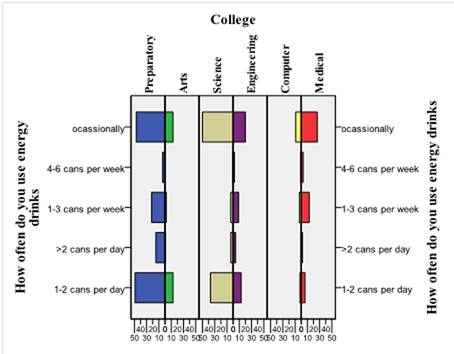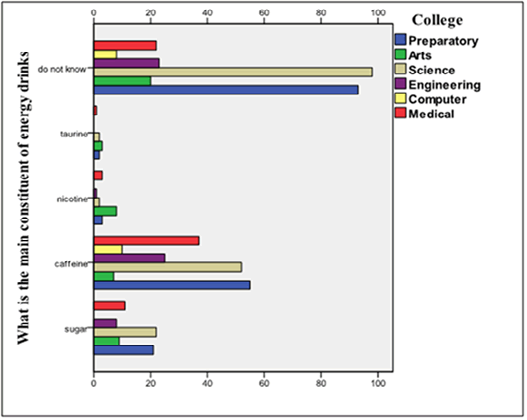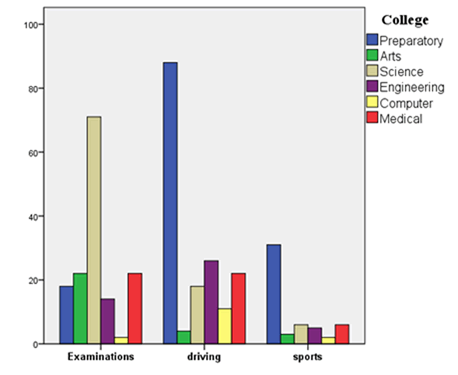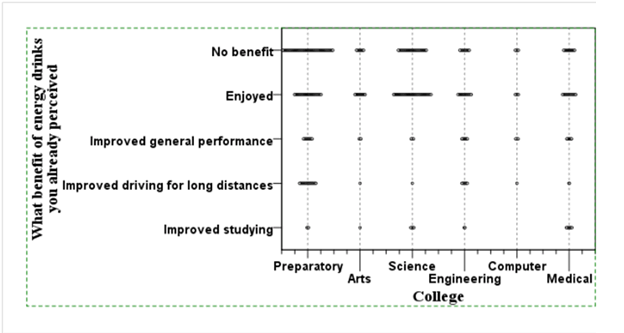ISSN: 0970-938X (Print) | 0976-1683 (Electronic)
Biomedical Research
An International Journal of Medical Sciences
- Biomedical Research (2016) Volume 27, Issue 2
Pattern of use and awareness of contents, benefits and adverse effects of energy drinks among university students in Rabigh, Saudi Arabia.
| Hussam AS Murad and Misbahuddin M Rafeeq* Department of Pharmacology, King Abdulaziz University, Jeddah, 21589, Saudi Arabia |
| Corresponding Author: Misbahuddin M Rafeeq Department of Pharmacology King Abdulaziz University Saudi Arabia |
| Accepted: January 30, 2016 |
There is widespread consumption of energy drinks especially by young population. Aggressive marketing in the name of performance improvement is directed towards young adults. Most consumers don't know about the largely unregulated constituents. High levels of caffeine and sugar often lead to adverse effects. This study was conducted among university students regarding consumption behaviour, awareness of constituents, perceived risks and benefits, and possible attitude modification. Selfadministered structured and validated questionnaire was distributed to university students and received back in unmarked sealed envelopes. Descriptive analysis, correlation and subgroup analysis was done. 548 respondents returned the filled questionnaire. Consumption was more in males. Maximum number of medical students stopped consumption due to adverse effects. 82% students acknowledged more harm than benefit. Media and internet were most common source of information. Majority have no knowledge about the main constituent except medical students who marked caffeine as answer. Main activity for consumption was driving followed by examination. As compared to others, medical students observed more side effects. Increased urine frequency was most common observed effect. Interventional measures were considered inappropriate by most respondents and they preferred healthcare personnel to educate them instead of commercial companies. Majority assured total discontinuation (46.3%) or a decrease in consumption (35.5%) of energy drinks. This study reinforced the findings of some previous studies but differed on many issues. The questionnaire incorporated some novel questions not addressed previously and subgroup analysis was also done. Energy drinks issue should be taken seriously by healthcare authorities.
Introduction |
||||||||
| Energy drinks are worldwide non-alcoholic beverages containing caffeine, taurine, glucuronolactone, vitamins, and sugar or sweeteners as main components. The producing companies say that such drinks improve performance and concentration. Most of the effects of energy drinks on cognitive performance are due to caffeine [1]. But caffeine also puts potential harms on health and performance. Usually, those using energy drinks are unaware of their constituents and this may cause caffeine toxicity and severe adverse effects [2]. Moderate caffeine consumption is tolerable in healthy people, while heavy consumption has been associated with many complications [3]. High concentrations of components of energy drinks could cause severe health adverse effects especially for those with cardiovascular disease [4]. In 2008, Babu et al. [5] thoroughly reviewed the patho-physiological effects of energy drinks and have thrown partial responsibility on the availability and aggressive marketing of energy drinks to the wide spread use among adolescents. Unfortunately, this wide spread use was associated by increasing reports of caffeine poisoning. Moreover, most components in energy drinks are not regulated. Consequently, potentially serious adverse effects may occur with use of such drinks and thus the authors recommended that patients should be inquired about use of energy drinks [6]. Increased heart rate and systolic blood pressure [7] and increased platelet aggregation and decreased endothelial function [8] were reported in healthy young adults with use of such drinks. This may be clinically relevant in patients having cardio-metabolic risk factors or those who consume regularly such drinks [9]. A case of ischemic stroke and tonic-clonic seizure was reported following intake of energy drink with alcohol on empty stomach in a 37 year old male [10]. Another case of Transient Ischemic Stroke was reported recently by Dikici et al 2015 in a young healthy male doctor who have taken two cans of “Redbull™” empty stomach with no other clinical and biochemical risk factors, family history and concomitant disease. Retinal artery constriction was implicated as a possible cause due to excess caffeine content [11]. Many brands of energy drinks such as Power Horse™, Bison™, Boom Boom™ and others are readily available in Saudi market in grocery stores and super markets. Thus, this study was designed to investigate the hypothesis that most university students whether use energy drinks or not, are either unaware or have a substandard knowledge about ingredients, benefits and harms of such drinks. Moreover, lack of this knowledge may be a cause for serious adverse effects. This work aims to collect consumption data of energy drinks, identify potential problems, assess the level of awareness of contents, benefits and harms of energy drinks, and to assess the possible behavioral change after the study. | ||||||||
Material and Methods |
||||||||
Study design |
||||||||
| A multiple response self-administered structured and validated questionnaire about knowledge, beliefs and attitudes towards consumption of marketed energy drinks was developed de novo with some reference from the previous studies [12-14]. It was reviewed and approved by the Research Ethics Committee, KAU (REC-KAU). | ||||||||
| Prior to distribution of the questionnaire, a pilot study was done with a selected group of students who were asked to fill out an initial questionnaire and return with comments and criticism. Respondents were selected on the basis of convenience sampling, and approached by at least one of the authors in person. Participation was purely voluntary and no names or IDs were asked. The questions asked were in Arabic language. The questionnaires were completed by the respondents in private and handed back to investigators in sealed and unmarked envelopes. | ||||||||
| The questionnaire included a full range of response options and was divided into three sections. The first part of the questionnaire consisted of a section on demographics such as age, sex, college of study and grade year. The second part of the questionnaire enquired information about the energy drinks. The respondent were asked to answer at first a binary response query, whether taking energy drinks or not, then proceed to rest of the questionnaire. More data about the consumption pattern of energy drinks like a) age at first exposure, b) initial stimulus, c) pattern of consumption including frequency and amount, d) any particular brand, and e) reasons for consumption, relation with meals and smoking etc, were documented in second part. The third and final part of the questionnaire elicited information about the constituents, perceived benefits and adverse effects of the energy drinks and the future habitual modification, whether decrease, keep same or stop consumption. | ||||||||
Study population |
||||||||
| Students of both sexes, aged 17 to 25 years of different faculties and grades at King Abdulaziz University, Rabigh campus. | ||||||||
Statistical analysis |
||||||||
| Data was analyzed using SPSS version 19.0 software. Descriptive analyses were done for all data to calculate frequencies of different variables. Chi square was used to evaluate the differences in responses’ frequency distribution. Additionally, spearman’s correlation coefficient was used to asses any correlation between the level of study and responses. A p value of <0.05 was considered statistically significant. | ||||||||
Results |
||||||||
| The present study was conducted in Rabigh campus of King Abdulaziz University, KSA. Out of the total number of questionnaires distributed, 548 (N) questionnaires were received showing a response rate of 83%. Reliability analysis of the questionnaire yielded a cronbach’s alpha value of 0.73. Table 1 shows the demographic characteristics of the study population. Out of the total female students, 43.9% showed less preference for energy drinks while only 22.7% of total male students affirmed similar response. The maximum consumption of energy drinks was observed in preparatory grade students. The most common starting age for energy drinks was 10-19 years in both sexes and all grades. | ||||||||
| Moreover, as depicted in Table 2, the science faculty students found energy drinks less favorable with more than 45% of total science students saying no to consumption of energy drinks. Interestingly, discontinuation due to adverse effects was maximally observed in medical students (17.7%). Intergroup relationship between initial (2nd and 3rd) year and final year medical students revealed that final year medical students have lesser preference for energy drinks and a greater percentage of students (40.9)% observed adverse effects as compared to initial year students (28.8)%. Similar trend was observed between initial year and final year science faculty students. A weak but significant correlation (r=0.12, p<0.01) was found between grade and consumption behavior. The most important factor in choosing a particular brand was taste as 80.7% (of respondents) agreed. | ||||||||
| Regarding the question on initial stimulus; curiosity emerged as the most common factor (60.5%) followed by friends provocation (20.6%) across all respondent groups. As for the family consumption behavior, sibling was the most common (51.8%) family member taking energy drinks, though 41.3% responded that no one in the family uses them. Moreover, a weak but highly significant correlation (r=0.13, P<0.001) was found between the individual’s consumption and family consumption behavior meaning thereby that those individual are more inclined towards energy drinks who already have a family member taking them. | ||||||||
| The data regarding the number of energy drinks was bimodal across different groups except computer and medical as shown in Figure 1. Most respondents were either taking them occasionally (<4 cans/week), or more frequently (1-2 cans/ day). There was a significant but weak correlation (r=0.17, P<0.001) between number of drinks and college of study. It was also found that preparatory and science faculty students were consuming more energy drinks as compared to others. | ||||||||
| A majority of students (82%) across all grades accepted that there is more harm in consumption of energy drinks as compared to benefits and main source of this information was media/internet (45%) followed by friends/relatives (29%). The consumption of energy drinks was not related to meals intake in most of the case as answered by 66.5%. Only a minority said that they take them with or after meals. But the relationship with smoking was almost equivocal as 42% found no problem and 58% preferred avoiding energy drinks along with smoking. | ||||||||
| Café was the most common place to take energy drinks by males followed by home (69.2% and 27.6%) across all groups, while females mostly take them at homes rather than in cafes (52.8% and 45.6%). This is expected because of the restricted movements of females. | ||||||||
| Regarding question on "main constituent of the energy drinks" (Figure 2), majority of students from preparatory, arts and science colleges responded that they have no knowledge about it while the next most common answer was caffeine. The medical students’ most common answer was caffeine. | ||||||||
| As depicted in Figure 3, driving was the most common situation for consuming the energy drinks for preparatory, engineering and computer college male students while examinations prompted more students from science and arts colleges to consume energy drinks. Medical students’ response was equivocal both for driving and examinations. Sports were the least preferred stimulus. Again due to the restricted movements of females, more than 74% females marked the examination as the preferred choice. There was a highly significant weak inverse correlation (r=-0.23, P<0.001) between the college and the preferred activity. | ||||||||
| Table 3 shows the most common reason for consumption of energy drinks. Majority of students across all colleges and sexes answered enjoyment (59.7%) as the main reason. | ||||||||
| Only a few said that they take them for improving performance. Figure 4 shows the perceived benefits from energy drinks. "No benefit" and/or "enjoyed" were the most common answer from all students. Majority of students form preparatory college perceived no benefit as compared to enjoyment (47.4% and 25.5%) , while this trend was reversed in students from all the other colleges who perceived more enjoyment from the drinks as compared to no benefit. | ||||||||
| Also more students from preparatory college perceived an improvement in driving. There was a highly significant moderate correlation (r=0.39, P<0.001) between reason for taking the energy drinks and perceived benefits. Overall, female respondents “enjoyed” the drinks more than male ones. As depicted in Table 4, majority of students from all colleges and both sexes (not shown) observed no adverse effects. Increased urination was the next most common answer regarding side effects. Some students (11.9%) observed heart palpitations. Interestingly further analysis showed that a high percentage of students from medical faculty (58%) observed one or the other side effects as compared to other faculties. | ||||||||
| Moreover, a comparison between initial and final year students revealed that a higher percentage (61.6%) of final year students observed at least one of the adverse effects. Also maximum percentage of students from preparatory college observed no side effects (63.5%). However, there was no correlation between the perception of adverse effects and college/grade of study. When asked about the current measures adopted by health authorities, 63.1% of the respondents marked them as inappropriate and not up to the mark. Further analysis revealed that this opinion is uniform across all colleges and both sexes. The most common remedy (59.3%) suggested by the majority of respondents was edification lectures by the healthcare staff followed by media advertisements in the university campuses. | ||||||||
| Regarding the behavioral change after this study, most of the students from all groups assured total discontinuation (46.3%) or a decrease in consumption (35.5%) of energy drinks. A small percentage mentioned that they will not change their consumption pattern (14.7%). Further analysis revealed interesting results as maximum percentage (51%) of students from medical and science faculty were willing to stop the consumption as compared to arts, computer and engineering. The opinions were almost similar in males and females. Moreover, no relationship was found between perception of any adverse effect and change in consumption behavior. | ||||||||
Discussion |
||||||||
| Energy drinks constitute a huge share in the edible items market. They are mainly directed at young population especially the student community. This study was conducted among the student population at Rabigh campus of King Abdulaziz University. The mean age of respondents in our study is less than a previous study [15] in Saudi Arabia and elsewhere [16]. This may implicate that younger people are more getting attracted to energy drinks. | ||||||||
| Moreover, the most common starting age for consuming these drinks is 10-19 years. This signifies the importance of an early intervention in the teenage. Regarding the consumption behavior of the respondents, it was found that, science faculty students have a lesser preference which may be attributed to a higher level of scientific knowledge regarding energy drinks. Medical students perceived more adverse events as compared to others which may be explained by the higher knowledge of adverse effects. Preparatory grade students were found to be the most frequent users. They are the youngest, new to the university and have less education and awareness compared to senior grades. These findings are unique to our study as most of the previous studies have not analyzed the responses according to the college of study. | ||||||||
| In agreement with a previous study [15], curiosity and friends’ advice were the most common initial stimulus. This implies that public health interventions should make available the relevant information from the school itself to end the “curiosity” factor at teenage. Moreover the individual consumption pattern has a correlation with family consumption, so there is a need of family based interventions for example advertisements in such programs which are attended and viewed by all family members. | ||||||||
| The frequency of taking energy drinks revealed a bimodal peak with the most common pattern was occasional intake followed by 1-2 cans/day. This pattern is different from a previous study [12,17]. This is particularly interesting with regard to intervention strategies which must be two-pronged directed at the occasional and frequent drinkers separately. A common strategy will be less advantageous in this case. | ||||||||
| A good indication is that despite aggressive advertisement and marketing strategies by the companies, majority of the students (82%) consider energy drinks more harmful than beneficial. Paradoxically, the most common source of this information was media and internet. This implies that they do not have a blind acceptance of the information bombardment done by the media. | ||||||||
| Most of the respondents except medical students did not have any knowledge about the main constituent of the energy drinks. This can be attributed to a higher level of knowledge among medical students regarding diet and nutrition. Caffeine followed by sugar; was the next common answers. These findings are in accordance with the previous studies [15,16]. | ||||||||
| There was a divided opinion among students from different colleges regarding the most preferred activity before which the energy drinks were consumed. The driving and examinations emerged as winners as compared to other activities. A closely related question enquiring about the principal reason to take energy drinks revealed an interesting finding as majority of the students answered “enjoyment”. | ||||||||
| Improvement of performance was replied by only a small percentage of respondents. This again shows a mature opinion considering the age of respondents and aggressive “performance improving” advertisements by companies. | ||||||||
| Our findings are similar to the study by Alsunni et al. 2011 [15], but differ with other studies due to cultural differences [12,16,18-20] where “increasing the energy” was the main response | ||||||||
| One of the distinct items in our questionnaire not present in previous studies was to enquire about the actual perceived benefits. It was observed that there was a huge gap between the reasons for taking the energy drinks and the actual perception of those benefits. No benefit and “enjoyment” were the most common answers for the preparatory and rest all other colleges respectively. Very few affirmed increased performance of driving and studying. | ||||||||
| The sense of enjoyment can be explained by the fact that caffeine is one of the main constituents of energy drinks responsible for a sense of well-being effect [21,22]. No perception of any benefit by the preparatory students may be partially explained by their lack of knowledge of the main constituent in the energy drinks. | ||||||||
| Observation of the adverse effects of drinks revealed an interesting picture. More than half of the respondents observed no side effects and this percentage was even greater in preparatory college (63.5%). Observation of side effects was greater in medical students overall and maximum in final year medical students. These findings may be attributed to the scientific knowledge gap regarding adverse effects among medical, preparatory and other colleges. | ||||||||
| Increased urination, palpitations and insomnia were the other common side effects in decreasing proportions respectively. These effects can be attributed to high amounts of caffeine and sugar [5,23-25]. Our findings are consistent with the mentioned previous studies. There are some reports but till now no strong link has yet been established between taurineand perceived side effects [26,27]. | ||||||||
| Additionally, a recent concise review by Dikici et al. highlighted the effect of individual components of energy drinks like caffeine, guaranine, taurine, ginseng, yohimbine etc. on pathophysiological functions in the body [28]. | ||||||||
| Most of the respondents gave an optimistic opinion regarding strategies to improve awareness of energy drinks and they preferred the authentic sources (healthcare professionals) instead of commercial companies’ advertisements. Moreover, a complete refrain or at least a reduction was promised by majority of the respondents. | ||||||||
Acknowledgement |
||||||||
| This work was funded by the Deanship of Scientific Research (DSR), King Abdulaziz University, Jeddah, under grant No. (828-287-D1435). The authors, therefore, acknowledge with thanks DSR for technical and financial support. The participation of the fourth year medical students, Rabigh College of Medicine (Omar Alghamdi, Abdulaziz Alghamdi, Abdulraouf Altaleb, Hatim Alamri) is gratefully acknowledged. | ||||||||
Tables at a glance |
||||||||
|
||||||||
Figures at a glance |
||||||||
|
||||||||
References |
||||||||
|



